Daniela Inclezan
Miami University
Architecture for Simulating Behavior Mode Changes in Norm-Aware Autonomous Agents
Feb 13, 2025Abstract:This paper presents an architecture for simulating the actions of a norm-aware intelligent agent whose behavior with respect to norm compliance is set, and can later be changed, by a human controller. Updating an agent's behavior mode from a norm-abiding to a riskier one may be relevant when the agent is involved in time-sensitive rescue operations, for example. We base our work on the Authorization and Obligation Policy Language AOPL designed by Gelfond and Lobo for the specification of norms. We introduce an architecture and a prototype software system that can be used to simulate an agent's plans under different behavior modes that can later be changed by the controller. We envision such software to be useful to policy makers, as they can more readily understand how agents may act in certain situations based on the agents' attitudes towards norm-compliance. Policy makers may then refine their policies if simulations show unwanted consequences.
* In Proceedings ICLP 2024, arXiv:2502.08453
An ASP Framework for the Refinement of Authorization and Obligation Policies
May 22, 2023Abstract:This paper introduces a framework for assisting policy authors in refining and improving their policies. In particular, we focus on authorization and obligation policies that can be encoded in Gelfond and Lobo's AOPL language for policy specification. We propose a framework that detects the statements that make a policy inconsistent, underspecified, or ambiguous with respect to an action being executed in a given state. We also give attention to issues that arise at the intersection of authorization and obligation policies, for instance when the policy requires an unauthorized action to be executed. The framework is encoded in Answer Set Programming. Under consideration for acceptance in TPLP.
Proceedings 35th International Conference on Logic Programming (Technical Communications)
Sep 17, 2019Abstract:Since the first conference held in Marseille in 1982, ICLP has been the premier international event for presenting research in logic programming. Contributions are sought in all areas of logic programming, including but not restricted to: Foundations: Semantics, Formalisms, Nonmonotonic reasoning, Knowledge representation. Languages: Concurrency, Objects, Coordination, Mobility, Higher Order, Types, Modes, Assertions, Modules, Meta-programming, Logic-based domain-specific languages, Programming Techniques. Declarative programming: Declarative program development, Analysis, Type and mode inference, Partial evaluation, Abstract interpretation, Transformation, Validation, Verification, Debugging, Profiling, Testing, Execution visualization Implementation: Virtual machines, Compilation, Memory management, Parallel/distributed execution, Constraint handling rules, Tabling, Foreign interfaces, User interfaces. Related Paradigms and Synergies: Inductive and Co-inductive Logic Programming, Constraint Logic Programming, Answer Set Programming, Interaction with SAT, SMT and CSP solvers, Logic programming techniques for type inference and theorem proving, Argumentation, Probabilistic Logic Programming, Relations to object-oriented and Functional programming. Applications: Databases, Big Data, Data integration and federation, Software engineering, Natural language processing, Web and Semantic Web, Agents, Artificial intelligence, Computational life sciences, Education, Cybersecurity, and Robotics.
An Application of ASP Theories of Intentions to Understanding Restaurant Scenarios: Insights and Narrative Corpus
Sep 30, 2018
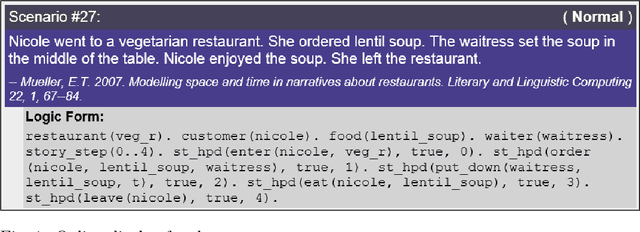
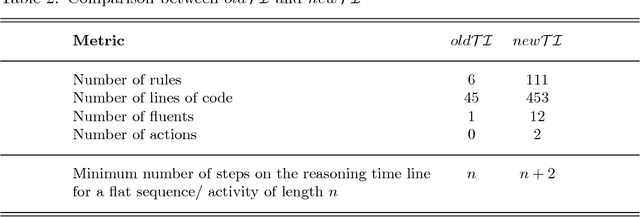

Abstract:This paper presents a practical application of Answer Set Programming to the understanding of narratives about restaurants. While this task was investigated in depth by Erik Mueller, exceptional scenarios remained a serious challenge for his script-based story comprehension system. We present a methodology that remedies this issue by modeling characters in a restaurant episode as intentional agents. We focus especially on the refinement of certain components of this methodology in order to increase coverage and performance. We present a restaurant story corpus that we created to design and evaluate our methodology. Under consideration in Theory and Practice of Logic Programming (TPLP).
An ASP Methodology for Understanding Narratives about Stereotypical Activities
Apr 26, 2018
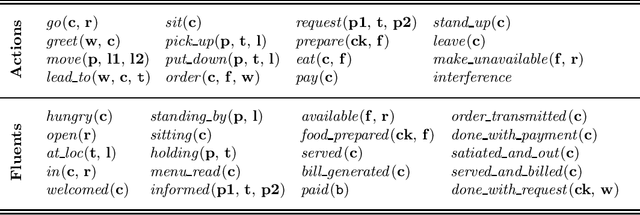

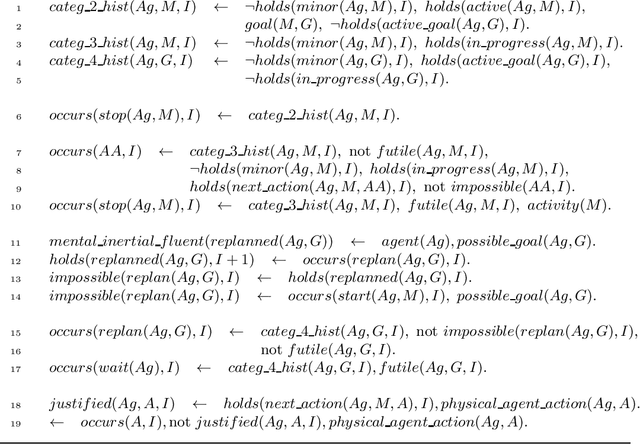
Abstract:We describe an application of Answer Set Programming to the understanding of narratives about stereotypical activities, demonstrated via question answering. Substantial work in this direction was done by Erik Mueller, who modeled stereotypical activities as scripts. His systems were able to understand a good number of narratives, but could not process texts describing exceptional scenarios. We propose addressing this problem by using a theory of intentions developed by Blount, Gelfond, and Balduccini. We present a methodology in which we substitute scripts by activities (i.e., hierarchical plans associated with goals) and employ the concept of an intentional agent to reason about both normal and exceptional scenarios. We exemplify the application of this methodology by answering questions about a number of restaurant stories. This paper is under consideration for acceptance in TPLP.
COREALMLIB: An ALM Library Translated from the Component Library
Aug 12, 2016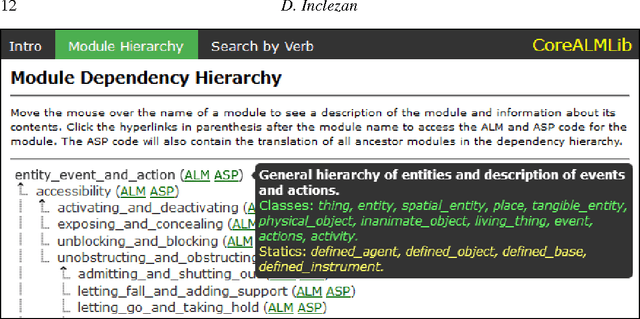
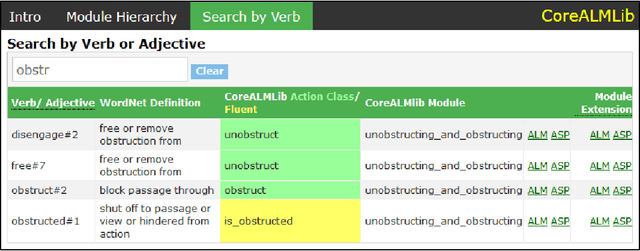
Abstract:This paper presents COREALMLIB, an ALM library of commonsense knowledge about dynamic domains. The library was obtained by translating part of the COMPONENT LIBRARY (CLIB) into the modular action language ALM. CLIB consists of general reusable and composable commonsense concepts, selected based on a thorough study of ontological and lexical resources. Our translation targets CLIB states (i.e., fluents) and actions. The resulting ALM library contains the descriptions of 123 action classes grouped into 43 reusable modules that are organized into a hierarchy. It is made available online and of interest to researchers in the action language, answer-set programming, and natural language understanding communities. We believe that our translation has two main advantages over its CLIB counterpart: (i) it specifies axioms about actions in a more elaboration tolerant and readable way, and (ii) it can be seamlessly integrated with ASP reasoning algorithms (e.g., for planning and postdiction). In contrast, axioms are described in CLIB using STRIPS-like operators, and CLIB's inference engine cannot handle planning nor postdiction. Under consideration for publication in TPLP.
Modular Action Language ALM
Jul 17, 2015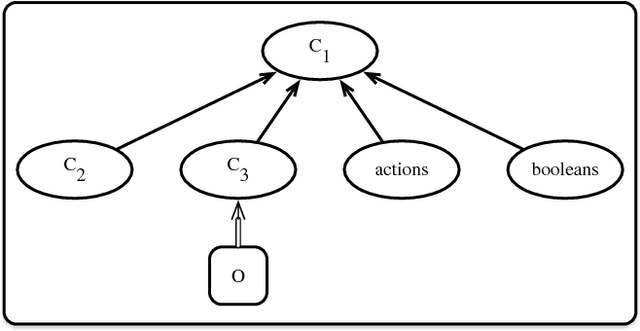
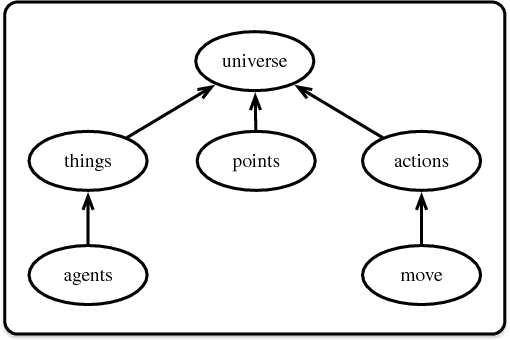
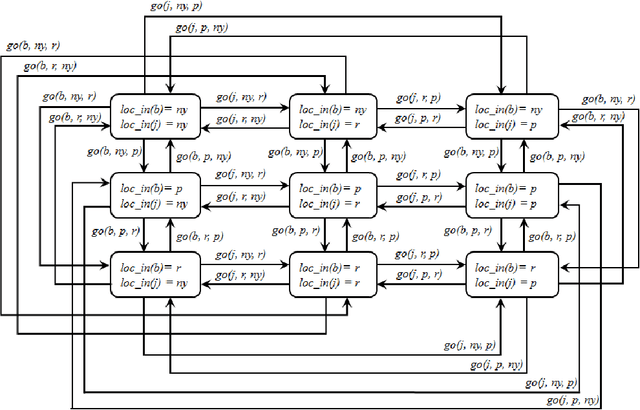
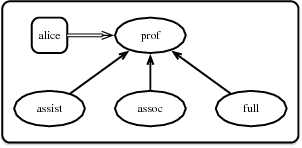
Abstract:The paper introduces a new modular action language, ALM, and illustrates the methodology of its use. It is based on the approach of Gelfond and Lifschitz (1993; 1998) in which a high-level action language is used as a front end for a logic programming system description. The resulting logic programming representation is used to perform various computational tasks. The methodology based on existing action languages works well for small and even medium size systems, but is not meant to deal with larger systems that require structuring of knowledge. ALM is meant to remedy this problem. Structuring of knowledge in ALM is supported by the concepts of module (a formal description of a specific piece of knowledge packaged as a unit), module hierarchy, and library, and by the division of a system description of ALM into two parts: theory and structure. A theory consists of one or more modules with a common theme, possibly organized into a module hierarchy based on a dependency relation. It contains declarations of sorts, attributes, and properties of the domain together with axioms describing them. Structures are used to describe the domain's objects. These features, together with the means for defining classes of a domain as special cases of previously defined ones, facilitate the stepwise development, testing, and readability of a knowledge base, as well as the creation of knowledge representation libraries. To appear in Theory and Practice of Logic Programming (TPLP).
* 65 pages, 7 figures. To appear in Theory and Practice of Logic Programming (TPLP)
An Application of Answer Set Programming to the Field of Second Language Acquisition
Dec 09, 2013Abstract:This paper explores the contributions of Answer Set Programming (ASP) to the study of an established theory from the field of Second Language Acquisition: Input Processing. The theory describes default strategies that learners of a second language use in extracting meaning out of a text, based on their knowledge of the second language and their background knowledge about the world. We formalized this theory in ASP, and as a result we were able to determine opportunities for refining its natural language description, as well as directions for future theory development. We applied our model to automating the prediction of how learners of English would interpret sentences containing the passive voice. We present a system, PIas, that uses these predictions to assist language instructors in designing teaching materials. To appear in Theory and Practice of Logic Programming (TPLP).
 Add to Chrome
Add to Chrome Add to Firefox
Add to Firefox Add to Edge
Add to Edge